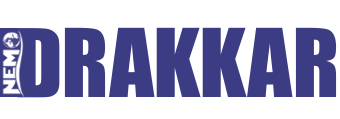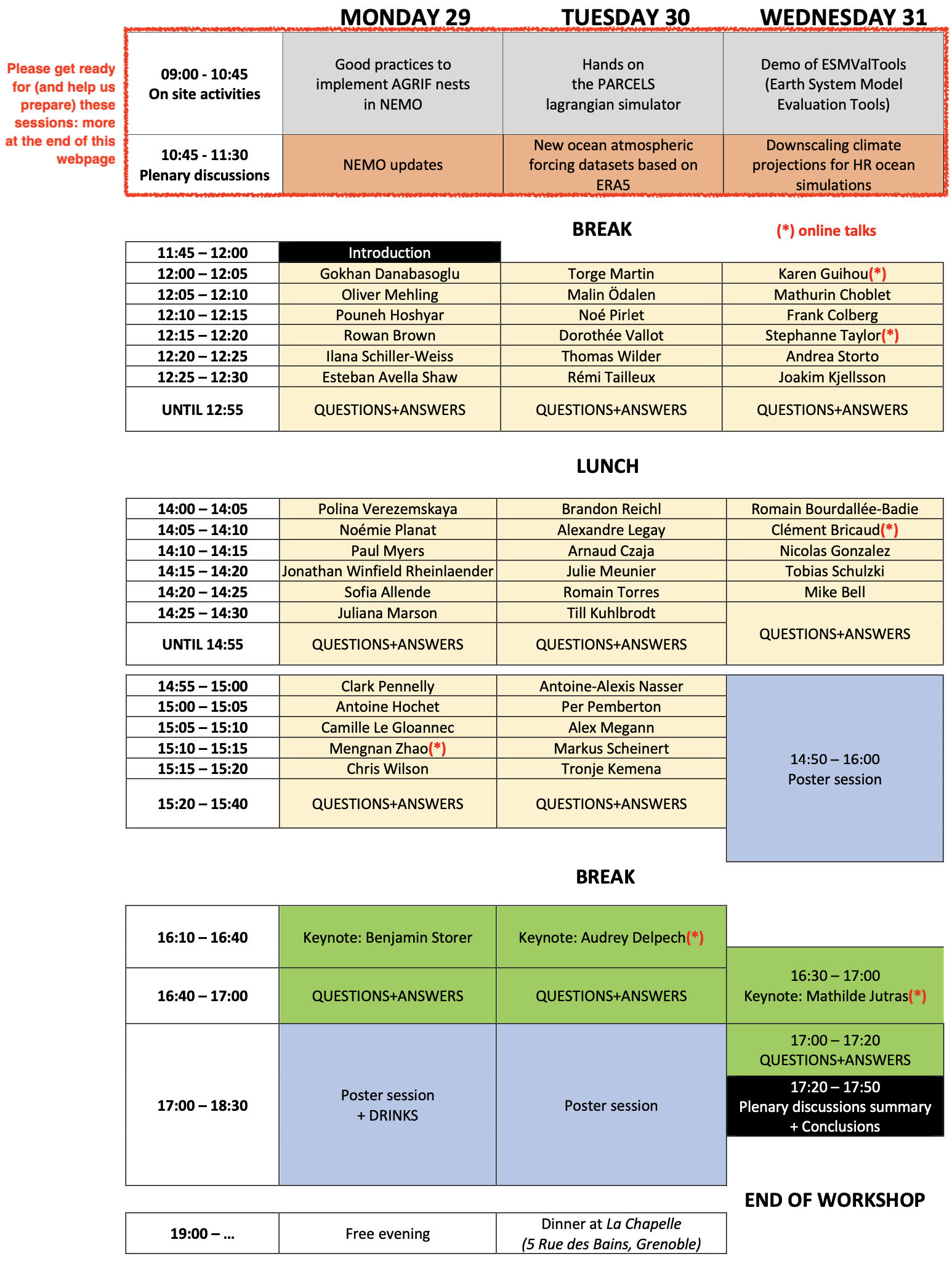|
|
|
Scientific Programme
The abstracts and posters of all scientific contributions are available here : https://cloud.univ-grenoble-alpes.fr/s/wEg5GzPYazDRn8g?path=%2Fscientific-contributions This tab provides (1) the programme of the workshop, (2) the list of keynote speakers and talks, and (3) the description of morning sessions.
(1) PROGRAMME
ON-SITE ONLY : Onsite activities, Poster sessions (gray and blue). And dinner of course ;) ON-SITE SESSIONS WITH VIDEO ACCESS : All other sessions
(2) KEYNOTE SPEAKERS AND TALKS Three keynote speakers will present their recent work during the workshop:
BENJAMIN STORER (Univ. Rochester). FlowSieve: Coarse-Graining to Gain Insight into Multi-Scale Dynamics Our understanding of the ocean’s spatial scales and their coupling has been derived mostly from Fourier analysis in small "representative" regions, typically a few hundred kilometers in size, that cannot capture the vast dynamic range at planetary scales. I will highlight the diagnostic power of coarse-graining, an analysis technique that allows us to scale-decompose complex flows while maintaining spatial information. While there are many established methods for coarsening data (e.g. block averaging), our approach preserves the underlying symmetries at different scales because our coarse-graining commutes with derivatives, allowing us to derive the dynamics of different scales self-consistently. I present results from analyzing a 1/12-degree reanalysis dataset on a range of spatial scales spanning more than three orders of magnitude, including both mesoscales and planetary scales. These results include a truly global kinetic energy (KE) wavenumber spectrum, as well as the first measurements of the global KE cascade across this entire range of scales. Further, by analyzing global spatial maps of KE transfer across scales, we find that the global atmospheric circulation cells (Hadley, Ferrel, Polar) induce direct energy exchanges between the gyre-scales and mesoscales, and that the Inter-Tropical Convergence Zone (ITCZ) induces intense localized downscale transfers in the ocean.
AUDREY DELPECH (Jet Propulsion Laboratory). Air-Sea interactions: a dissipation mechanism for oceanic internal waves? Internal waves contain a large amount of energy in the ocean and are an important source of turbulent mixing. Ocean mixing is relevant for climate because it drives vertical transport of water, heat, carbon and other tracers. Understanding the life cycle of internal waves, from generation to dissipation, is therefore important for improving the representation of ocean mixing in climate models. Here, we provide evidence from a regional realistic numerical simulation in the northeastern Pacific that the wind can play an important role in damping internal waves through current feedback. This results in a reduction of 67% of wind power input at near-inertial frequencies in the region of study. Wind-current feedback also provides a net energy sink for internal tides, removing energy at a rate of 0.2 mW/m on average, corresponding to 8% of the local internal tide generation at the Mendocino ridge. The temporal variability and modal distribution of this energy sink are also investigated.
MATHILDE JUTRAS (Univ. Hawaï). Lagrangian simulations and machine learning to study the retroflection of the Labrador Current The Labrador Current transports cold, relatively fresh, and well-oxygenated waters from the subarctic to the subpolar North Atlantic and along the western American continental shelf. Varying contributions to either regions strongly influences the water physical and chemical properties, leading for instance to the recent significant warming and deoxygenation of the eastern North American coast. Here, we investigate the pathways of the Labrador Current using a large set of Lagrangian trajectories advected by the velocity field of the GLORYS12V1 ocean reanalysis model. We show that Machine Learning can successfully classify Lagrangian tracks according to their pathways, allowing to identify two main pathways and four minor pathways for the Labrador Current waters. The bulk of the waters are retroflected eastward at the Grand Banks of Newfoundland, while most of the remainder follows the coast, in varying proportions through time. To understand what drives this variability, we develop an index of the retroflection. Our analyses reveal that strong retroflection generally occurs when a large-scale circulation adjustment, related to the subpolar gyre, accelerates the Labrador Current and shifts the Gulf Stream northward, partly driven by a northward shift of the zero-wind-stress-curl line in the western North Atlantic. Starting in 2008, a particularly strong northward shift of the Gulf Stream dominates the other drivers. (3) DESCRIPTION OF MORNING SESSIONS (please get ready as suggested)
ON-SITE ACTIVITY : Good practices to implement AGRIF nests in NEMO This session will be an open discussion of best practices, issues and practical aspects from groups using AGRIF. Based on data collected before the meeting, information and statistics about groups running AGRIF, and the associated configurations, will be presented. Issues related AGRIF setups, experiments, issues, tools will be discussed. The goal is to understand the different applications of AGRIF, and how to better share knowledge among the groups using AGRIF. PLENARY DISCUSSION: NEMO updates In this session, representatives of the NEMO system team and the NEMO developer committee will give you a quick update of the upcoming release, what plan for next year and how you can contribute to NEMO:
ON-SITE ACTIVITY : Hands on the PARCELS lagrangian simulator Parcels (Probably A Really Computationally Efficient Lagrangian Simulator) is a python framework for analysing the ocean from the Lagrangian perspective. A range of particles can be modelled and tracked, such as water masses, passive tracers, plastic, fish, even icebergs. Currently in development is the PlasticParcels tool, a beginner-friendly interface for the Parcels framework in the specific context of tracking microplastic particles. Designed for use on the Copernicus Marine Service platform, PlasticParcels combines state-of-the-art physics parameterisations for microplastic transport with the latest inventory of plastic sources along coastlines, rivers, and fisheries. In this session we will introduce users to the Parcels python framework, and provide hands-on experience using Parcels by “beta-testing” the PlasticParcels tool using NEMO hydrodynamic data. PLENARY DISCUSSION: A new dataset to force ocean - sea-ice models based on ERA5 The ocean modeling community needs common / standard atmospheric datasets suitable to perform forced, multi-decadal ocean simulations. Such simulations are needed for: evaluation, understanding, and improvement of the ocean components of Earth system models; investigation of mechanisms for seasonal, inter-annual, and decadal variability; attribution of ocean-climate events; evaluation of robustness of mechanisms across models; and bridging observations and modeling, by complementing ocean reanalysis from data assimilation approaches. A framework defining a protocol and the needed forcing datasets exist as part of the Ocean Model Intercomparison Project (OMIP). The current OMIP forcing dataset is based on the Japanese Reanalysis (JRA-55) product which is being discontinued. To address this challenge, NSF NCAR, NOAA GFDL, and DOE LANL will lead an effort – also in collaboration with the international ocean modeling community – to create a new set of forcing datasets based on the ECMWF ERA5 reanalysis product. The project will follow the approach used in the creation of the previous versions of the dataset, but will address identified issues to the extent possible. The goals of this session are to introduce the project and, more importantly, to obtain feedback and suggestions from the NEMO community as the project starts.
ON-SITE ACTIVITY : Demo of ESMValTools (Earth System Model Evaluation Tools) ESMValTool is a community diagnostics package for analysing earth system model data in the context of CMIP. This session will consist of a short talk giving an introduction to ESMValTool (and comparing to other diagnostics packages), followed by an opportunity to have some hands-on experience generating ocean model diagnostics from CMIP data. In parallel there will be an opportunity for questions and discussion. The session aims to give people with no previous experience a flavour of what ESMValTool is and how it works. PLENARY DISCUSSION: Downscaling climate projections for HR ocean simulations Building on hindcast work (such as in DRAKKAR), scientific communities are increasingly turning to high-resolution forced ocean models (both regional and global, for ocean physics, waves, sea-ice, biogeochemistry) to improve our understanding of future climate impacts in the marine environment, beyond that which can be obtained from CMIP-type climate projections alone.
|



